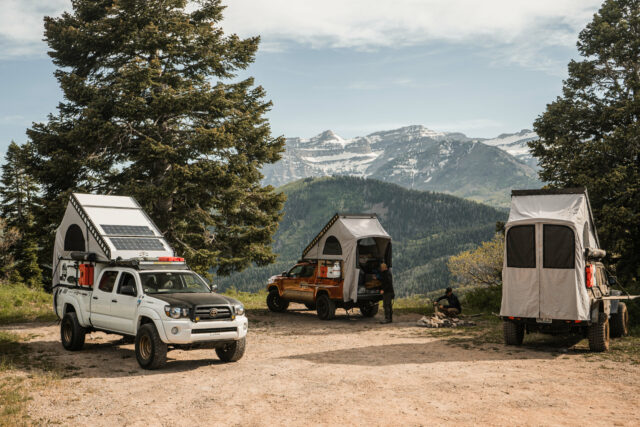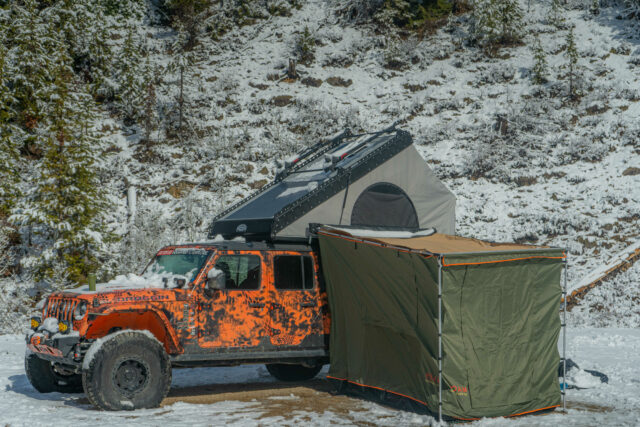When traveling overland for long periods of time, you soon realize that interior living space is the ultimate luxury, and almost no other aspect of an overland vehicle is as desirable, with the exception of maneuverability and reliability. At the Overland Expo Pacific NorthWest event, we came across the Harker Outdoors Expedition Driven Camper (EDC) and immediately recognized a concept that is an innovation, bringing together the best of both a wedge camper and a rooftop tent. Not only does the EDC offer a practical use of space and materials (for instance, the rear hatch is repurposed as a side table) the base price is quite refreshing.

The EDC concept took shape in 2019 when Harker Outdoors embarked on a mission to redefine the overland camper experience. Led by the affable co-founder and lead designer Joe Harker, the team set three crucial design objectives: eliminate the need to duck or crawl to enter the camper, maximize standing room and interior living space, and maintain a swift 60-second deployment time with a weight limit of 300 pounds.



Essentially, the EDC is a wedge camper with canvas walls and a large canvas zip tailgate annex, which liberates and extends the interior space. The walk-in entry captures the tailgate as additional living space, and the tailgate annex, in conjunction with a lift-away sleep platform that can be raised to the ceiling while retaining 5 inches of bedding, effectively transforms what was once wasted space into prime interior living quarters. As a result, Harker Outdoors claims that the EDC boasts an impressive 100% more standing room than its segment counterparts. You have the freedom to adapt the load area and living space to your exact needs; this camper offers space for a family, an adventurous solo traveler, or a couple who would like to store all their outdoor and adventure gear within the vehicle.

Additionally, Harker Outdoors has prioritized exterior gear storage, allowing travelers to store items like traction boards and gas cans using their standard L-track mounting system. This design maximizes interior living space but also keeps dirty gear outside the living quarters.

One of the key highlights of the EDC is its swift deployment time, taking less than a minute to set up (without annex walls), and the camper maintains a trim 300-pound base weight for the midsize offering, ensuring it remains easily transportable and does not overburden the base vehicle. We all know that overloading a vehicle is far too common in the overland space. And, being as light as an old-school rooftop tent, the EDC does not significantly hinder the performance and maneuverability of the base vehicle, an important consideration for those who like to get far from the beaten trail.

Harker Outdoors also offers a lineup of premium optional equipment for the EDC. Their in-house 12-volt brand, Dirt Circuit, offers custom 240-watt solar panels, allowing campers to fit two panels on the roof for an impressive 480 watts of solar power. Additionally, the EDC features an innovative in-wall LiFePO4 Lithium battery, boasting a mere 2-inch thickness. Other optional features include windows, access hatches, fans, and a flat-mounted Starlink satellite dish, catering to the diverse needs of modern adventurers.

The camper is compatible with nearly all midsize and full-size pickups, with 8-foot truck beds being the only notable exclusion, and currently, lead times for the EDC are estimated to be 4-6 weeks.

Harker Outdoors has undoubtedly crafted something special with their Expedition Driven Camper. Yes, this camper does have its limitations, and most of those are due to the employment of a canvas annex. But, and this is a big but, wherever you could explore with a canvas rooftop tent, you could travel with the EDC, and only an Arctic winter would present a serious challenge (the other significant challenge could be high winds, but that can be addressed by parking well and employing guy ropes). In fact, we would suggest that the EDC does not suffer the limitations of a rooftop tent and is actually a superior camping option. Would we travel the world with the EDC? I do think so, yes. A hard-side camper is preferable for most global overland travel but not essential, and the lightweight construction and practical available space make this a great camper for long or short-term travel. And, besides, the views must be incredible.
Starting price from $9,000.
Our No Compromise Clause: We do not accept advertorial content or allow advertising to influence our coverage, and our contributors are guaranteed editorial independence. Overland International may earn a small commission from affiliate links included in this article. We appreciate your support.


